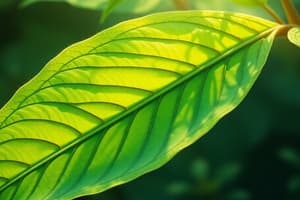Podcast
Questions and Answers
What is the primary function of the cuticle layer in a leaf?
What is the primary function of the cuticle layer in a leaf?
- To produce chlorophyll
- To facilitate photosynthesis
- To store carbohydrates
- To prevent water loss and regulate gas exchange (correct)
Where are the chloroplasts, or organelles, responsible for photosynthesis mainly found?
Where are the chloroplasts, or organelles, responsible for photosynthesis mainly found?
- Leaves (correct)
- Flowers
- Roots
- Stems
Which layer of the leaf enables sunlight to pass through and initiate photosynthesis?
Which layer of the leaf enables sunlight to pass through and initiate photosynthesis?
- Spongy layer
- Palisade layer
- Upper epidermis (correct)
- Cuticle layer
What is the main function of the stomata in a leaf?
What is the main function of the stomata in a leaf?
What is the adaptation of the cuticle layer in dry, arid climates?
What is the adaptation of the cuticle layer in dry, arid climates?
What is the process by which plants convert light energy into cellular energy?
What is the process by which plants convert light energy into cellular energy?
What is the main function of leaves in plants?
What is the main function of leaves in plants?
What is the primary function of the palisade layer in a leaf?
What is the primary function of the palisade layer in a leaf?
What type of cells are found in the spongy layer of a leaf?
What type of cells are found in the spongy layer of a leaf?
What is the main function of the stomata in a leaf?
What is the main function of the stomata in a leaf?
What is the role of the guard cells in a leaf?
What is the role of the guard cells in a leaf?
What is the term for the middle region of the leaf, consisting of the palisade and spongy layers?
What is the term for the middle region of the leaf, consisting of the palisade and spongy layers?
What is the primary function of the xylem in a leaf?
What is the primary function of the xylem in a leaf?
What is the term for the process of regulating water loss in a leaf?
What is the term for the process of regulating water loss in a leaf?
What is the function of the lower epidermis in a leaf?
What is the function of the lower epidermis in a leaf?
Study Notes
Layers of a Leaf
- Leaves are responsible for facilitating photosynthesis in plants, which involves converting light energy into cellular energy.
- The layers of a leaf include: cuticle layer, upper epidermis, palisade layer, spongy layer, lower epidermis, and stomata.
Cuticle Layer
- The cuticle layer is a waxy layer on the external surface of leaves, secreted by the epidermis.
- It prevents water loss from the leaf, controls the entrance and exit of carbon dioxide and oxygen, and protects against physical and chemical damage.
- The cuticle layer adapts to different climates, being thicker in dry climates and thinner in moist climates.
Upper Epidermis
- The upper epidermis is a thin layer of cells that enables sunlight to pass through and initiate photosynthesis.
- It helps prevent excessive water loss (transpiration) and regulates carbon dioxide and oxygen absorption and release.
- The cells of the upper epidermis do not possess chloroplasts, where photosynthesis takes place.
Palisade Layer
- The palisade layer consists of columnar cells where most photosynthesis takes place.
- These cells are tightly packed together to absorb sunlight and produce energy.
- The palisade layer is primarily responsible for conducting cellular respiration.
- It can consist of several layers of cells, particularly in environments with high sunlight.
Spongy Layer
- The spongy layer consists of irregularly shaped cells spaced apart from each other.
- It facilitates the diffusion of nutrients and gases (carbon dioxide, oxygen, and water) through the stomata.
- The spongy layer stores products of photosynthesis derived from the palisade layer and contains vascular bundles responsible for transporting nutrients throughout the plant.
Lower Epidermis
- The lower epidermis is a continuation of the epidermal cells on the upper surface of the leaf.
- It secretes the waxy substance associated with the cuticle layer and facilitates gas exchange via the stomata.
Stomata
- Stomata are pores in the lower epidermis where gas exchange occurs.
- They regulate the amount of carbon dioxide, oxygen, and water that enters and exits the leaf.
- Stomata are unable to open and close on their own, relying on guard cells to control their opening and closing.
- Guard cells contain chloroplasts and detect changes in light, hydration, and temperature to determine when to open or close the stomata.
Studying That Suits You
Use AI to generate personalized quizzes and flashcards to suit your learning preferences.
Description
Learn about the structures of a leaf, including chloroplasts, and their role in facilitating photosynthesis in plants.




